Astronomy - Palling Around With the Palomar Globular Clusters
The intriguing Palomar globular clusters will challenge observers with modest to large telescopes, while providing a satisfying ramble around the galactic halo. Seize the upcoming dark of the Moon to make their acquaintance.
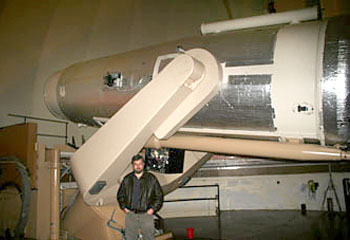
Scott Kardel, public affairs coordinator for Palomar Observatory, stands at the 48-inch Schmidt camera used for the first Palomar Observatory Sky Survey in the 1950s.
Sky & Telescope archives
Sky & Telescope archives
Back when the Palomar clusters were discovered, a Coke cost a nickel and a quarter would buy you a burger at a Mom-and-Pop diner. We currently know of about 157 globular clusters in Milky Way galaxy, 15 of which were discovered on the survey plates of the first Palomar Observatory Sky Survey(POSS) in the 1950s.
The astronomers who identified this globular subset named for the famous observatory are some of profession's most famous practitioners including Edwin Hubble, Walter Baade, Fritz Zwicky, George Abell, Milton Humason, and Halton Arp.
All but two — Palomar 7 (IC 1276) and Palomar 9 (NGC 6717) — had never been seen before, and with good reason. Palomar 6, 7, 9, 10 and 11 are heavily obscured by interstellar dust along our line of sight, while several others, including Palomar 3, 4 and 14, inhabit the remote outer halo of the galaxy. Despite their size, distance robs them of their radiance. When it takes a 48-inch Schmidt camera to dig these out, you know they're objects to be reckoned with.
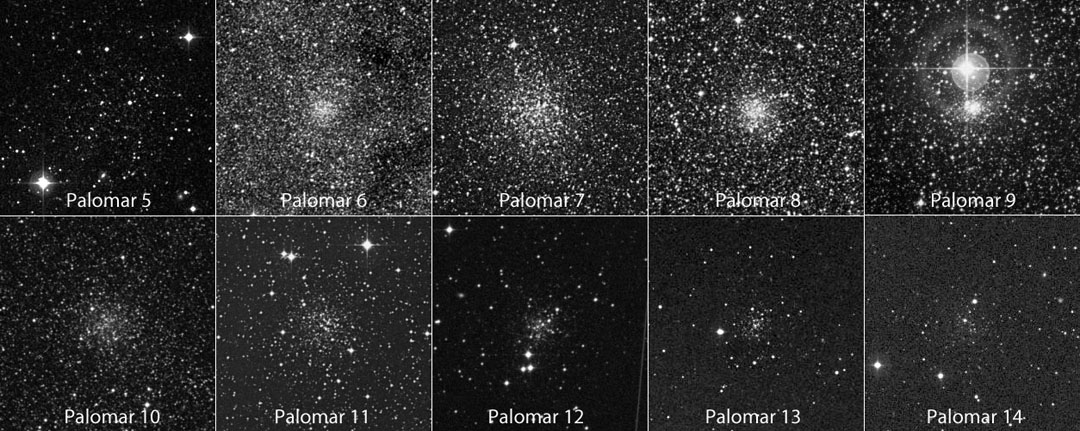
Meet the crew! These are the 10 featured Palomar globular clusters we'll explore in this article. All images are from the Digital Sky Survey. North is up and each square measures 10′x10′ across. Click to enlarge.
Fortunately, not all of the globular clusters present an impossible challenge. A couple are visible in 8-inch scopes and most in a 16-inch. Palomar 9 is surprisingly bright and was first spotted by none other than William Herschel on August 7, 1784, long before the hamburger was even invented.
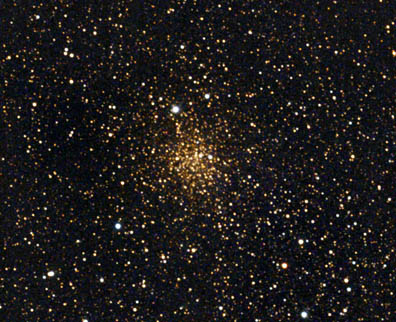
Palomar 7 is not only one of the brightest in the bunch but it's also relatively easy to resolve into individual stars.
Gregg Ruppel
Gregg Ruppel
Ditto for IC 1276 (Palomar 7), first seen by American astronomer Lewis Swift of comet fame in 1889 and independently rediscovered by George Abell in 1952 during the survey.
The clusters range from easy-peasy Palomar 9 at magnitude +9.3 to the eye-numbing Palomar 14 at +14.7. Many are found in the summer sky, so we'll concentrate on those, making good use of the upcoming "dark window" when the bright Moon departs the scene starting about August 21st.
My observations were made with a 15-inch (37-cm) reflector under Bortle 3-4 skies (rural to rural-suburban transition) in early August. Of the 10 globular clusters attempted, I saw seven, suspected one and was defeated by two. I hope my notes, along with the finder charts created by amateur astronomer Alvin Huey, will prompt you to pursue these faint but fascinating objects that dot our galaxy's exoskeleton like lanterns in the night.
* Palomar 5 in Serpens (R.A. 15h 16.1m, Dec. –00° 07′): Magnitude 11.8, Diameter 8′: Located ½° south of 6th-magnitude 4 Serpentis. Nothing visible at 64× magnification. Increasing the power to 142× and 245×, I caught hints of a relatively large, misty patch using averted vision. Extremely faint. No stars or granulation noted.
* Palomar 6 in Sagittarius (R.A. 17h 43.7m, Dec. –26° 13.3′): Magnitude 11.6, Diameter 1.2′: Too low from my location and compromised by light pollution. Not visible ... at least this time around!

This color image of Palomar 8 nicely captures its granulated appearance in the telescope.
Anthony Ayiomamitis
Anthony Ayiomamitis
* Palomar 7 in Serpens (R.A. 18h 10.7m, Dec. –07° 12.5′) : Magnitude 10.3, Diameter 8′: This large, easy cluster jumped out right away at 64× and was well-resolved with a magnification of 142×. I could see lots of faint twinkles across its core along with a bright 13th-magnitude star anchoring the cluster's northeastern border.
* Palomar 8 (R.A. 18h 41.5m, Dec. –19° 49.5′) in Sagittarius: Magnitude 11.0, Diameter 5.2′: A scrap of fog about 2′ across easily visible even at 64×. Upping the magnification to 142× and using averted vision, the cluster appears granulated with little central concentration. 242× reveals a clumpy appearance with a good number of very faint stars resolved at the limit of vision.
* Palomar 9 in Sagittarius (R.A. 18h 55.1m, Dec. –22° 42.1′): Magnitude 9.3, Diameter 5.4′: Absolutely fascinating object! Located immediately south of and in the glare of Nu2 Sgr, a beautiful 5th-magnitude gold-colored star. Although the listed size is over 5′, I saw a much smaller clump of gems a third as big shaped like a king's crown. A magnification of 142× did a nice job showing about a dozen distinct stars. Averted vision and higher magnification added a few more. You'll enjoy its tininess, unique shape, and relative brightness compared to the some of the other Palomars.

Cat's paw? King's crown? Palomar 9's shape depends on your field orientation (north is up here) and what scope you're using. The bright star is Nu2 Sgr.
Anthony Ayiomamitis
Anthony Ayiomamitis
* Palomar 10 in Sagitta (R.A. 19h 18m, Dec. +18° 34.3′): Magnitude 13.2, Diameter 4.0′: After trolling the low declinations, how nice to finally tilt the scope into higher, less soupy skies! Good thing, too, because this faint cluster requires inky blackness. I confirmed seeing an exceedingly faint ball of stellar vapor at 142× with averted vision. No stars were resolved.
* Palomar 11 in Aquila (R.A. 19h 45.2m, Dec. –08° 0.5′): Magnitude 9.8, Diameter 10.0′: I assumed the cluster's large size might dash hopes of seeing it, but I was happily proven wrong. 64× showed a faint, round haze at the correct location with quivering granulation visible at 142×. With the scalpel-like precision of high magnification (245×) coupled with averted vision, I could partially resolving the cluster into minute pinpoints.
* Palomar 12 in Capricornus (R.A. 21h 46.6m, Dec. –21° 15′): Magnitude 12.0, Diameter 2.9′: Good lord, this one's small! The upside was that it was more compact than most of the Palomars. I used 245× and saw a 20″ diameter dab of fuzz with a slightly brighter center. Neither granulation nor stars were visible.
* Palomar 13 in Pegasus (R.A. 23h 06.7m, Dec. +12° 46.3′): Magnitude 13.8, Diameter 0.7′: I suspected but couldn't confirm a small, faint glow at the position using 242× and averted vision.
* Palomar 14 in Hercules (R.A. 16h 11.1m, Dec. +14° 57.5′): Magnitude 14.7, Diameter 2.2′: The faintest of the Palomars. Problematic field stars made this a no-show for me despite 20 minutes of trying. Pal 14 is the most remote globular in our sample — an extreme halo object — located 225,000 light-years from the galactic center and 241,000 from the Sun.
Below you'll find finder charts for several of the brighter Palomar globulars courtesy of Alvin Huey's excellent and free observing guide, Globular Clusters. Click the link and download the .pdf, which includes maps of the remaining clusters and more than 100 others north of –50° declination. The Palomars are also plotted in the Uranometria 2000.0 atlas.

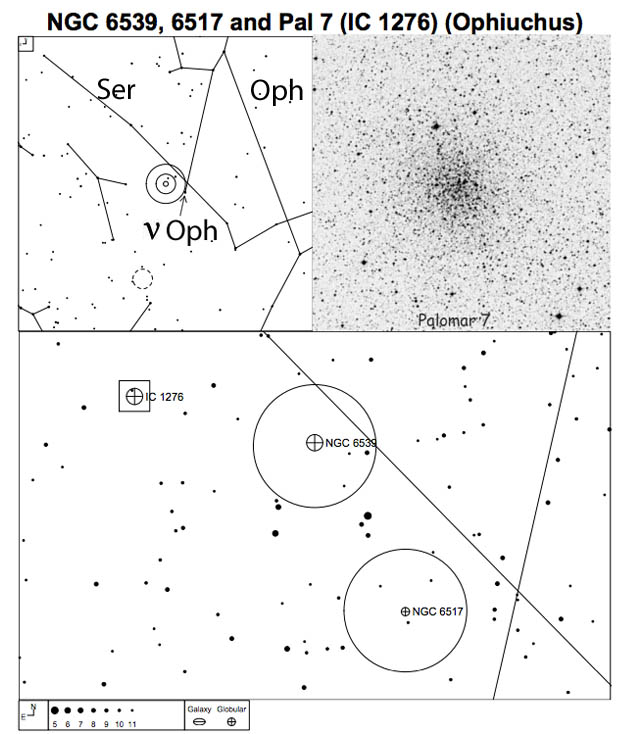
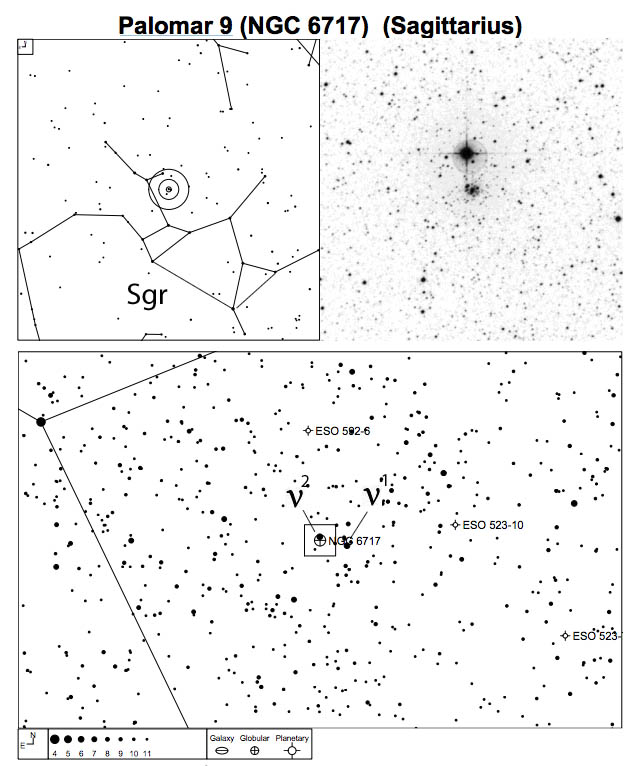


No comments:
Post a Comment